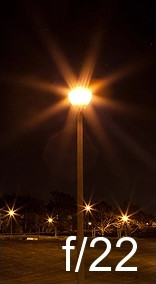In photography, it's well known that reducing the aperture leads to the starburst effect, like in the following photo:
This happens due to diffraction on the aperture, which has a polygonal shape when closed. The smaller the aperture, the wider the spikes. This is easy to understand, because this is the case of Fraunhofer diffraction, where the far field is basically the Fourier transform of the aperture indicator function.
Now, there's something strange that I observe with my own human eyes. The experiment goes as follows.
- Long after sunset get your eyesight adapted to a well-lit room.
- Turn off room lights and extra light sources like e.g. computer monitor, so that the room is dark, this will make your eye pupils maximally wide.
- Come to a window and look at the faraway street lights. You'll see the spikes similar to the photo above, but less regular (we don't have so regular polygons in our eyes as photo cameras do :) ).
- Up to this point everything seems fine. Now take a bright source of light (e.g. phone display with max brightness) and, without obscuring the city lights, bring it close to the eyes, so as to activate pupillary light reflex. DON'T HARM YOURSELF! Use your common sense regarding brightness of the display of your particular device (some high-end phones have really bright displays)!
- What you'll see will be the opposite to what happens when you close the aperture in a camera: the diffraction spikes will smoothly shrink. The shrinkage starts exactly when you feel your iris sphincter muscle activate.
- You can check that this is not simply veiling glare effect: move the light away from the eyes, and the spikes will smoothly grow back. I.e. you'll still see them small for some time.
- You can also check that it's not a (de)focusing effect: try e.g. focusing at your window, still keeping the street light at the same point in sight (maybe obscuring it for one eye to make it easier to do). The defocused street light will look very different from the most spiky version of the focused image.
I can sometimes consciously play with the width of my pupils in the dark (this is an elusive ability, due to the indirect nature of control over iris muscles), and the effect is exactly the same, which confirms that this is not due to veiling glare or similar masking effects.
What makes me wonder is the observation in step 5: why does constricting pupil lead to lessening of the diffraction smearing of the light sources? Shouldn't it behave similarly to photographic systems, where the smearing increases?

